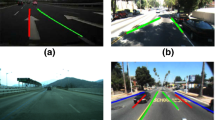Abstract
In most actual autonomous guided vehicles (AGV), path finding and navigational control systems are usually implemented using images captured by cameras mounted on the vehicles. This paper presents and discusses a lane boundary detection technique that is necessary for the task of autonomous driving. In this paper, a new method called vector fuzzy connectedness (VFC) is presented to detect and estimate road lane boundaries. First, a preprocessed technique is used to obtain a skeleton image. Based on the result, the curvatures of the left and right lane boundaries are estimated, and the control points are found by the VFC method. Finally, the non-uniform b-spline (NUBS) interpolation method is introduced to construct the road lane boundaries. The proposed VFC method integrates the vector concept and fuzzy connectedness into the lane boundary detection algorithm. As shown in the example results, the proposed method can extract various road lane shapes and types from real road frames even under complex road environments. For navigation tasks, it is necessary to determine the position of the vehicle relative to the road. These results prove that the proposed detection method can assist in a number of actual AGV assistant applications. In the future, some intelligent techniques will be applied to test the AGV system with obstacle avoidance conditions on real world roads.














Similar content being viewed by others
References
Keysermann MU, Vargas PA. Towards autonomous robots via an incremental clustering and associative learning architecture. Cogn Comput. 2015;7(4):1–20.
Javadi MS, Hannan MA, Samad SA, Hussain A. A robust vision-based lane boundaries detection approach for intelligent vehicles. Inf Technol J. 2012;11(23):1184–92.
Savitha R, Suresh S, Kim HJ. A meta-cognitive learning algorithm for an extreme learning machine classifier. Cogn Comput. 2013;6(2):253–63.
Hsiao PY, Yeh CW, Huang SS, Fu LC. A portable vision-based real-time lane departure warning system: day and night. IEEE Trans Veh Technol. 2009;58(4):2089–94.
Han J, Kim D, Lee M, Sunwoo M. Enhanced road boundary and obstacle detection using a downward-looking LIDAR sensor. IEEE Trans Veh Technol. 2012;61(3):971–85.
Saunders R. Towards autonomous creative systems: a computational approach. Cogn Comput. 2012;4(3):216–25.
Czubenko M, Kowalczuk Z, Ordys A. Autonomous driver based on an intelligent system of decision-making. Cogn Comput. 2015;7(5):1–13.
Rodrı’guez LF, Ramos F. Development of computational models of emotions for autonomous agents: a review. Cogn Comput. 2014;6(3):351–75.
Kala R, Warwick K. Heuristic based evolution for the coordination of autonomous vehicles in the absence of speed lanes. Appl Soft Comput. 2014;19(2):387–402.
Fernando S, Udawatta L, Horan B, Pathir P. Real-time lane detection on suburban streets using visual cue integration. Int J Adv Robot Syst. 2014;11(1):1–20.
Son J, Yoo H, Kim S, Sohn K. Real-time illumination invariant lane detection for lane departure warning system. Expert Syst Appl. 2014;42(4):1816–24.
Wadhwa J, Kalra GS, Kranthi BV. Real time lane detection in autonomous vehicles using image processing. Res J Appl Sci Eng Technol. 2015;11(4):429–33.
Wang J, Gu F, Zhang C, Zhang G. Lane Boundary Detection Based on Parabola Model. IEEE International Conference on Information and Automation. 2010. p. 1729–1734.
Li Q, Chen L, Li M, Shaw SL. A sensor-fusion drivable-region and lane-detection system for autonomous vehicle navigation in challenging road scenarios. IEEE Trans Veh Technol. 2014;63(63):540–55.
Wang J, An X. A Multi-step Curved Lane Detection Algorithm Based on Hyperbola-Pair Model. IEEE International Conference on Automation and Logistics. 2010. p. 132–137.
Shin BS, Tao J, Klette R, Shin BS. A superparticle filter for lane detection. Pattern Recogn. 2014;48(11):3333–45.
Kim ZW. Robust lane detection and tracking in challenging scenarios. IEEE Trans Intell Transp Syst. 2008;9(1):16–26.
Li XY, Fang XZ, Wang C, Zhang W. Lane detection and tracking using a parallel-snake approach. J Intell Robot Syst. 2015;77(3–4):597–609.
Gayathiri S K, Ramachandran K I. Lane Change Detection and Tracking for a Safe-Lane Approach in real time Vision based Navigation Systems. Comput Sci Inf Technol. 2011;345–361.
Fan C, Xu JB, Di S, Shi XF. Lane detection based on parallel Hough transform. J Comput Inf Syst. 2013;12(9):4893–900.
Anik S, Dipanjan DR, Tauhidul A, Kaushik D. Automated road lane detection for intelligent vehicles. Global J Comp Sci Technol. 2012;12(6):1–6.
Gary B, Adrian K. Learning OpenCV: computer vision with OpenCV library. O’Reilly Media. 2009.
Chihab N, Zergahoh A, Astruc JP. Generalized non-uniform B-spline functions for discrete signal interpolation. IEEE Int Symp Signal Process Appl. 2003;2:129–32.
Udupa JK, Samarasekera S. Fuzzy connectedness and object definition: theory, algorithm and applications in image segmentation. Graph Model Im Proc. 1996;58(3):246–61.
Sampath S, Sivaraj N. Fuzzy connectedness based segmentation of fetal heart from clinical ultrasound images. Advanced computing, networking and informatics. Springer International Publishing 2014;1:329–33e7.
Ciesielski KC, Herman GT, Kong TY. General theory of fuzzy connectedness segmentations. J Math Imaging Vision. 2016;55(3):304–42.
Author information
Authors and Affiliations
Corresponding author
Ethics declarations
Funding
This study was funded by the Education Department of Liaoning Province (grant number L2014423), and the Natural Science Foundation of China (grant number 41671439, 61402214).
Ethical Approval
This article does not contain any studies with human participants or animals performed by any of the authors.
Conflict of Interest
The authors declare that they have no conflict of interest.
Rights and permissions
About this article
Cite this article
Fang, L., Wang, X. Lane Boundary Detection Algorithm Based on Vector Fuzzy Connectedness. Cogn Comput 9, 634–645 (2017). https://doi.org/10.1007/s12559-017-9483-3
Received:
Accepted:
Published:
Issue Date:
DOI: https://doi.org/10.1007/s12559-017-9483-3




